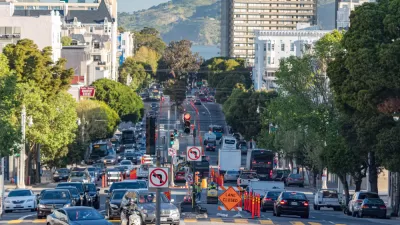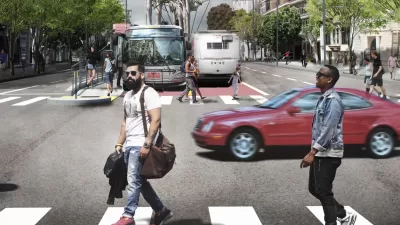The Van Ness Improvement project took almost two decades to cross the finish line, but it's almost there.

San Francisco has been working on the Van Ness Improvement Project, which includes the controversial addition of bus rapid transit lanes, for a decade and a half. Now a column by Carl Nolte reveals that the long haul is finally on the home stretch in a paywalled article for the San Francisco Chronicle.
First, here's how Nolte sums up the experience of planning, building, and waiting for the Van Ness Improvement project:
Van Ness has been torn up for the city to build an ambitious bus rapid transit corridor 2 miles long from Lombard to Mission streets. Two special lanes, just for buses, were built, along with landscaping, street trees and wider sidewalks. The project was designed to speed up local Muni buses and regional Golden Gate Transit service. It seemed like a great idea when it was in the planning stage. “When it’s done you’ll be thanking us,” Mayor London Breed said when she was president of the Board of Supervisors. But the work took forever. There were delays and cost overruns. It was the mess on Van Ness.
Nolte's exploration of the project includes a tour of the city that reaches back beyond the Roaring 20s, when Van Ness transitioned from the city's "grandest boulevard" to its auto row. Now new development is again transforming the buildings around Van Ness, punctuated by an ambitious rezoning and redevelopment effort at Van Ness and Market called The Hub.
Planetizen's coverage of the Van Ness Improvement project stretches back to 2006. A San Francisco Civil Grand Jury investigated the Van Ness Improvement project, asking where the project went wrong after winning funding from voters in 2003, but waiting until 2016 to break ground and then until about now to complete construction. A separate article by Kevin Truong reports the findings of the Grand Jury's investigation, providing a comprehensive account of the project's long history.
FULL STORY: The bandages are coming off: Check out S.F.’s new Van Ness Avenue

Planetizen Federal Action Tracker
A weekly monitor of how Trump’s orders and actions are impacting planners and planning in America.

Map: Where Senate Republicans Want to Sell Your Public Lands
For public land advocates, the Senate Republicans’ proposal to sell millions of acres of public land in the West is “the biggest fight of their careers.”

Restaurant Patios Were a Pandemic Win — Why Were They so Hard to Keep?
Social distancing requirements and changes in travel patterns prompted cities to pilot new uses for street and sidewalk space. Then it got complicated.

Platform Pilsner: Vancouver Transit Agency Releases... a Beer?
TransLink will receive a portion of every sale of the four-pack.

Toronto Weighs Cheaper Transit, Parking Hikes for Major Events
Special event rates would take effect during large festivals, sports games and concerts to ‘discourage driving, manage congestion and free up space for transit.”

Berlin to Consider Car-Free Zone Larger Than Manhattan
The area bound by the 22-mile Ringbahn would still allow 12 uses of a private automobile per year per person, and several other exemptions.
Urban Design for Planners 1: Software Tools
This six-course series explores essential urban design concepts using open source software and equips planners with the tools they need to participate fully in the urban design process.
Planning for Universal Design
Learn the tools for implementing Universal Design in planning regulations.
Heyer Gruel & Associates PA
JM Goldson LLC
Custer County Colorado
City of Camden Redevelopment Agency
City of Astoria
Transportation Research & Education Center (TREC) at Portland State University
Camden Redevelopment Agency
City of Claremont
Municipality of Princeton (NJ)




























